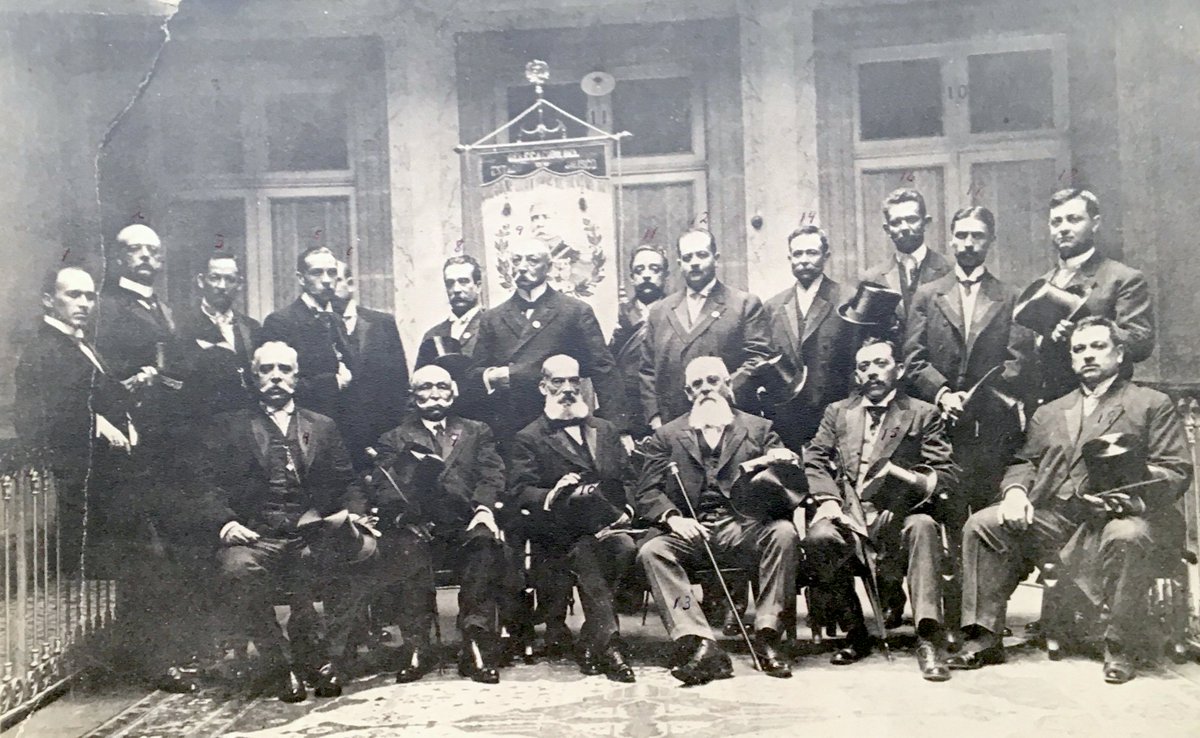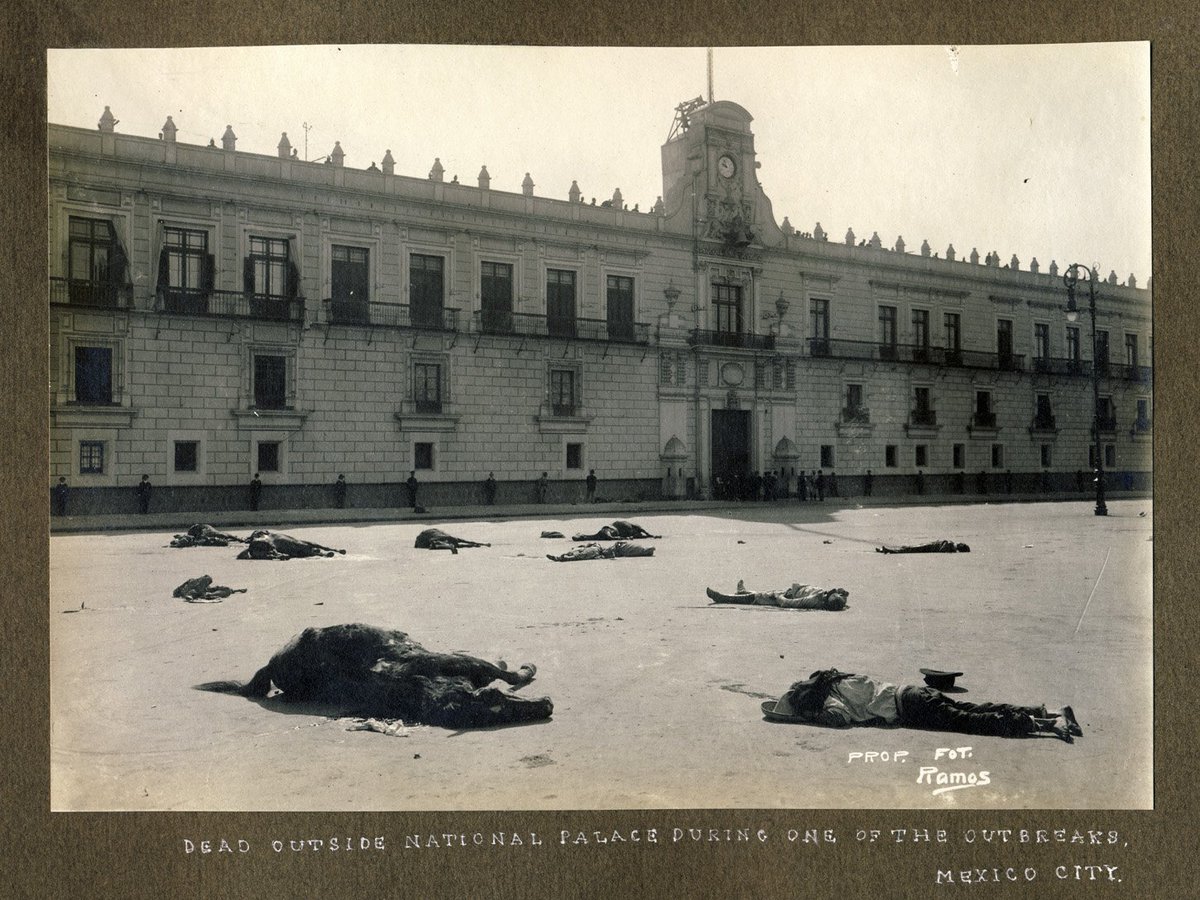It's almost Day of the Dead, so I'll be sharing a bit about the life of José Cuervo. (Yes, a real guy.)
For unknown reasons, @JoseCuervo, the brand, hasn't answered my requests for access to their archives for years.
So please boost w/ RTs. Let's recover this history together!
For unknown reasons, @JoseCuervo, the brand, hasn't answered my requests for access to their archives for years.
So please boost w/ RTs. Let's recover this history together!

José Cuervo Labastida, the second son of Malaquías Cuervo Flores and Francisca Labastida, was born on October 9, 1869, on the hacienda El Pasito in the foothills west of the town of Tequila in Jalisco. He was christened two days later in the parish church in Tequila. 



Malaquías Cuervo was already a successful maker of vino mezcal (later known as vino tequila or simply tequila) at El Pasito and the neighboring hacienda, San Martín, where he had a small-scale distillery (or fábrica). 



By 1880, Malaquías's tequila was being distributed in Guadalajara by his uncle Jesús Flores, who owned a distillery of his own called La Rojeña. 

Flores was also distributing tequila made by Malaquías's brother, Florentino Cuervo, at Hacienda El Carmen. (Florentino's old hacienda house and historic distillery still stand.) At the start of the 1880s, the Cuervo family controlled an empire in the Tequila Valley. 





By then, José (far right in this photo) had numerous brothers and sisters, and Malaquías envisioned a day in the near future when his children would each run a distillery or hacienda in his empire.
But then, a series of tragedies befell the Cuervo family.
But then, a series of tragedies befell the Cuervo family.

In 1887, Malaquías died of cholera. Then, Francisca Labastida was diagnosed with uterine cancer. When she couldn't make payments, the bank seized her properties and sold them to a new nemesis—an ambitious young man named Cenobio Sauza who owned the distillery La Perseverancia. 



By 1896, the Cuervo siblings were orphaned and landless. José took a job with his great-uncle Jesús Flores, as manager of one of his agave estates at the lowly wage of 40 pesos per month. It must have seemed like an end to his dreams, but it was the start of a new empire. 



Tomorrow: we'll see Jose Cuervo rise again—and come to define the tequila industry. (And just a reminder: If you like this thread, please retweet to let @JoseCuervo know that there's interest in the history of the company and the Cuervo family.) More soon! 

One other coda for today: The Sauza family descendants and everyone at @drinkfortaleza and @Sauza have been very, very helpful. Like… VERY helpful. 

So when we left off, José Cuervo was managing an agave farm. (Here's a photo of a jimador, taken by @MaryAnneAndrei, who shot all of the modern photos in this thread. Special thanks to @UFWupdates!)
After less than a year, Cuervo was promoted.
After less than a year, Cuervo was promoted.

Jesús Flores, Cuervo's great-uncle, fell ill and was bed-ridden in Guadalajara at his mansion, known as Casa de los Perros. (Flores had installed iron guard dogs on each corner of the roof.) In Flores's absence, Cuervo was put in charge of his distillery, La Rojeña, in Tequila. 



When Flores died, Cuervo married his widow, Ana González Rubio, and took over as proprietor of the distillery in Tequila. With his new wealth, Cuervo also rapidly acquired land. By 1905, he had more than 4 million agaves in cultivation. 



Before long, Cuervo put his own name on the brand—and created one of the most iconic labels in the history of the industry. 

He also built a massive new headquarters in Guadalajara with a home for his wife and adoptive niece, Lupita, on the upper floor. Business was booming. But then, the economy stalled, and many began calling for the ouster of the aging dictator, Porfirio Díaz. Revolution loomed. 

President Díaz promised to permit free elections in 1910. Cuervo feared instability and violence if Díaz was removed. He was appointed to Díaz's reelection committee (back row, center right, marked "14"), and Cuervo ran for the state congress of Jalisco himself. 

Cuervo was elected to the legislature and named president of the body, but it was too late. Revolution was unstoppable. In May 1911, Leopoldo Leal (right) and Cleofas Mota led an uprising in Tequila with backing from Cuervo's younger brother, Ignacio. 



More to come today as war grips Mexico, the U.S. stages multiple invasions, and chaos threatens to destroy the tequila industry for good. (And thanks to all for sharing @JoseCuervo in time for #DayOfTheDead #DiaDeLosMuertos!) 



So... Leopoldo Leal was killed by federal troops in Magdalena, west of Tequila, but the revolution of Francisco I. Madero succeeded. (This portrait of Madero was in Leal's pocket when he was killed.) Cuervo's brothers Malaquías and Ignacio sent a telegram to congratulate Madero. 



At first, it seemed like the start of a new era, but Madero struggled to effect change and his supporters split into factions. In February 1913, a coup, later known as the Ten Tragic days, was launched with help from the US—leaving General Victoriano Huerta in control of Mexico. 



Now, the tequila industry was in trouble. Huerta controlled Mexico City, but opposition forces marched down the west coast and toward Guadalajara. The Tequila Valley became a battleground.
The railroad was blown up. Telegraph lines cut. The town cannonaded. Distilleries burned.

The railroad was blown up. Telegraph lines cut. The town cannonaded. Distilleries burned.


Between October 1913 and July 1914, the town of Tequila was destroyed four times. The danger was so severe by spring of 1914 that nearly all of the major tequila-makers went into hiding together—living in a cluster of adobe huts at the bottom of the barranca north of Tequila.
In July 1914, General Álvaro Obregón overtook Guadalajara. He arrived in the city center in a motor car—and paused to be photographed across the street from Cuervo's business office and home. Cuervo believed that the victory of the anti-Huerta forces would bring peace to Mexico. 

Instead, the new government tried Cuervo for treason.
(More to come tomorrow. Thanks again to everyone for retweeting this thread to let @JoseCuervo know that there's interest in the history of the company and its legendary founder. #DayOfTheDead #DiaDeLosMuertos)
(More to come tomorrow. Thanks again to everyone for retweeting this thread to let @JoseCuervo know that there's interest in the history of the company and its legendary founder. #DayOfTheDead #DiaDeLosMuertos)

So... The case against Cuervo was dismissed after some explosive testimony from none other than Eladio Sauza (left)—son of Cuervo's old rival, Cenobio Sauza. Cuervo had reconciled with the Sauzas during his months in hiding and had become especially close to Luís Sauza (right). 



But Cuervo's troubles were far from over. Guadalajara kept changing hands—between the forces of Venustiano Carranza (who had tried him) and Pancho Villa, who ordered the executions of several Cuervo family members. Both sides commandeering trains cut off all tequila shipments. 

So Cuervo formed his own distribution company (headed by his cousin José Gómez Arreola), and he bought his own steam engines and rail cars to transport his tequila to Guadalajara, Mexico City, and north to the U.S. border. 



One aside for tequila aficionados: By 1917, Cuervo had tequila that had been stored in barrels unable to reach the market for years. As his train restored shipments, he sold that aged product as a new kind of tequila comparable to fine cognacs. He called it Supremo Tequila Añejo. 



But then, British intelligence intercepted what came to be known as the Zimmermann telegram, a message from the German Foreign Office proposing an alliance between Mexico and Germany if the U.S. entered World War I against Germany. 

John R. Silliman, the American consul in Guadalajara, became convinced that José Cuervo y Cia. was one of three firms collaborating with the German government in preparation for a possible invasion of the United States. Cuervo was placed on the Enemy Trading List by the U.S. 

Silliman claimed Cuervo was using sales of tequila to buy weapons and then using his railcars to transport those guns to the border. It was pure fantasy, based only on the fact that Cuervo's nephew, Juan Beckmann, was the German consul in Guadalajara. But Cuervo was blacklisted. 

To get around the U.S. ban on Cuervo's exports and to sidestep a new wave of domestic taxes imposed on all tequila-makers by now-president Venustiano Carranza, Cuervo proposed forming an industry cooperative. It came to be known as the Junta de Mezcaleros. 

Thus, a gray market for tequila began, just weeks after the U.S. had ratified the Volstead Act.
(More tomorrow. Thanks to everyone for retweeting this thread to let @JoseCuervo know you're interested in the history of the company and its founder. #DayOfTheDead #DiaDeLosMuertos)
(More tomorrow. Thanks to everyone for retweeting this thread to let @JoseCuervo know you're interested in the history of the company and its founder. #DayOfTheDead #DiaDeLosMuertos)

Okay, it's #DiaDeLosMuertos #DayOfTheDead, so let's close thing out. And as always, many thanks for retweeting this thread to let @JoseCuervo know that there's interest in the history of their brand and their legendary founder. 

So José Cuervo was banned from exporting his tequila to the United States and was facing severe new taxes—imposed by President Venustiano Carranza, in hopes of rebuilding Mexico after the revolution. Cuervo and Eladio Sauza met with Carranza to lobby against the tax, to no avail. 

Then something remarkable happened. The Junta de Mezcaleros became an underground syndicate. In simple terms, the tequila-makers combined to form a market monopoly, using Cuervo's railroads and distribution channels, and fixing prices. For one year, they would not compete. 

The goal was simple: Get as much tequila to the U.S. border as possible by the end of 1919. There was to be a brief gap between the wartime prohibition on liquor expiring at the end of 1919 and enforcement of the Volstead Act due to go into effect on January 17, 1920.
Unfortunately, the partnership was due to expire in August 1920, just as Mexico geared up for its first post-revolution elections. Amid political disagreements, the Sauzas renewed the partnership with all parties—except the Cuervos.
Despite José's best efforts to prevent violence, his brothers pushed the conflict to the brink of war with the Sauza family. This culminated memorably with José's older brother Malaquías firing his pistol in the air on the plaza and shouting, "Death to the fucking Sauzas!"
In January 1921, José went to Mexico City to try to broker a peace agreement among all parties. Instead, he fell desperately ill. Officially, José was diagnosed with pneumonia, but his brother Carlos, a member of Congress, fell ill at the same time. Rumors spread of poisoning.
That's it for the life of José Cuervo. The long battle between his brothers and the Sauza family is a story for another time (that I'll save for my book). In the meantime, thanks for reading—and for sharing with @JoseCuervo! #DayOfTheDead #DiaDeLosMuertos
• • •
Missing some Tweet in this thread? You can try to
force a refresh






